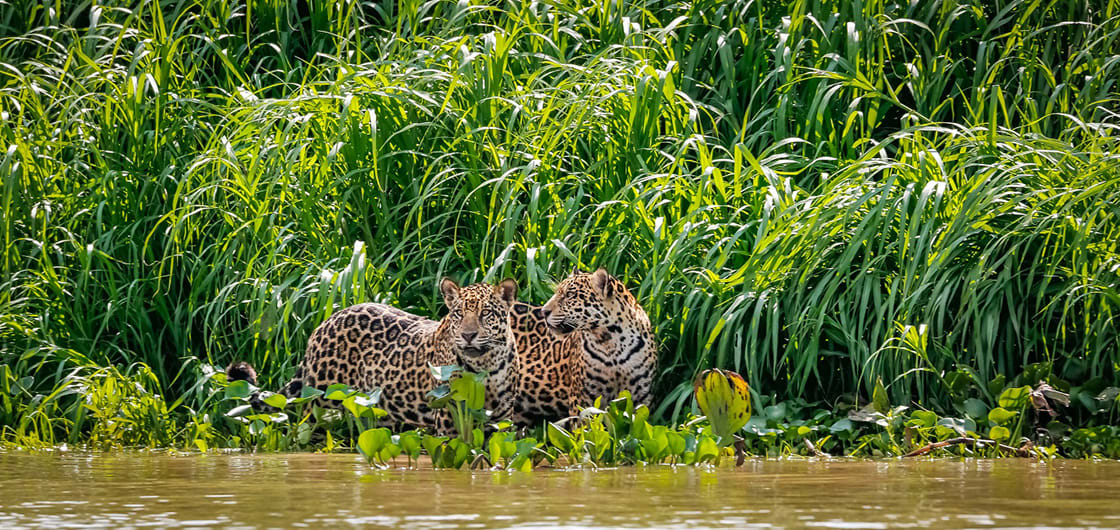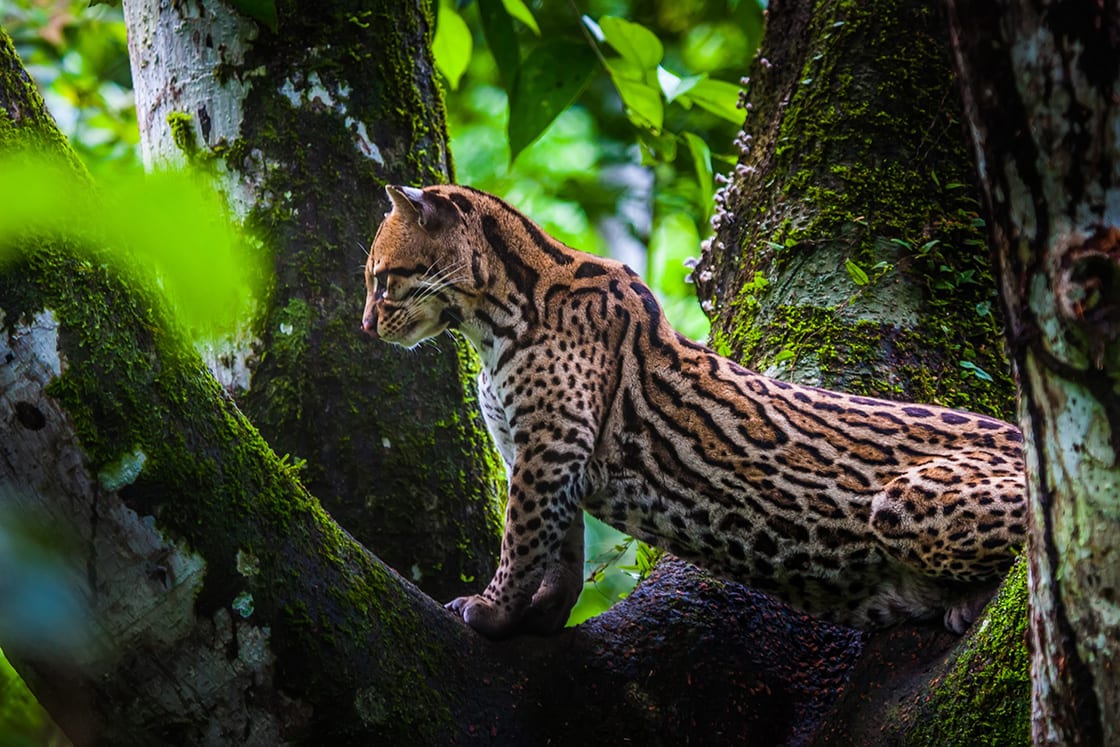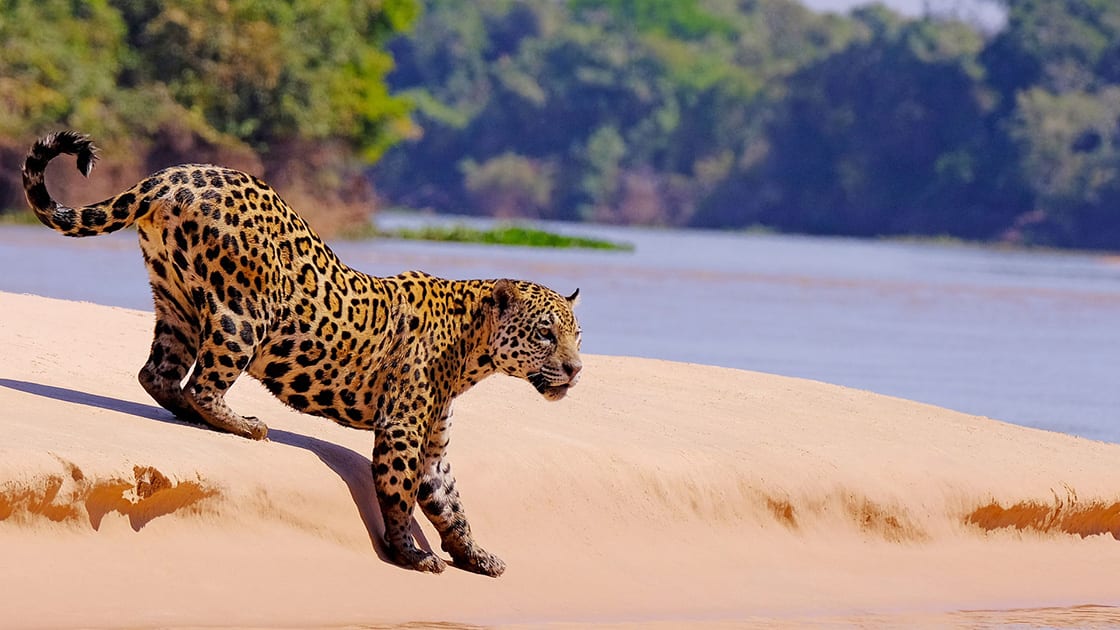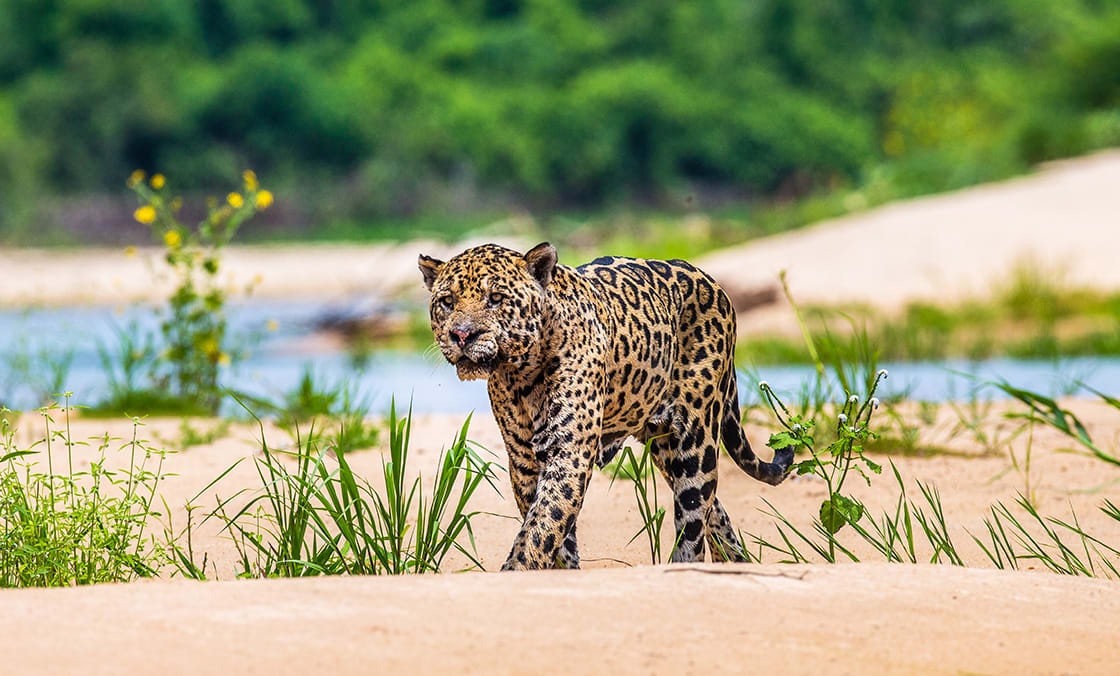
Here is our list of the top 10 facts about jaguars. If you are lucky enough, you might spot one on your Amazon river cruise or Pantanal tour.
1. The name jaguar comes from the Native American word yaguar, which means “he who kills with one leap.” These powerful hunters sometimes climb trees to prepare ambushes and jump down on their prey. One reason for this is that despite jaguars being rapid runners they tire quickly, so rely on proximity rather than sustained speed while hunting.

Two Jaguar Brothers Standing On A River Edge In Pantanal. Brazil
2. Young cubs are born blind and helpless. They stay with their mother, who brings them up alone, for around two years for protection and learning the required skills to hunt independently in the future. Once they reach the age of three, jaguars become solitary animals, typically meeting only to mate (although a recent study suggests that they actually encounter each other and spend more time together than we ever anticipated with some jaguars traveling together on occasion).

Oncilla Wild Cat On A Tree In Ecuador
3. Although jaguars are famous for their easily recognized rose-like black markings (rosettes) all over their tawny-colored bodies, they can vary from reddish-brown to black. Black (melanistic) jaguars, also called black panthers, still have the typical markings but they are virtually hidden by the excess black pigment melanin.
4. In ancient Central and South American cultures, the jaguar is regarded as a symbol of strength and bestowed as a prominent character in religion, mythology, and art. Worshiped by the Aztecs, jaguars were positioned as guardians of their sacred temples and they even named an elite class of warriors the Jaguar Knights. In Maya civilizations the jaguar was the formidable God of the Underworld and helped the sun travel under the Earth at night, ensuring it would rise each morning. The Olmecs understood jaguars to be divine gods possessing the ability to jump-start earthquakes.
5. Jaguars have an astounding repertoire of calls, including a variety of snarls, growls, and “roars,” (by the way, only members of the genus Panthera, i.e. the four big cats, namely lion, tiger, jaguar, leopard, can roar) which are more aptly described as a series of hoarse coughs or grunts. Although when they are younger it sounds a bit different! When air passes through the larynx on the way from the lungs, the cartilage walls of the larynx vibrate, producing sound.

Young Jaguar Walking Towards The Water In Pantanal
6. Unlike many cats, jaguars don’t avoid water, in fact, they are the most water-loving of the cats and actually tend to live near it, their habitat ranging from rainforests such as the Amazon to seasonally flooded swamp areas, like the Pantanal in Brazil. To end the myth completely, they are also good swimmers and eat turtles, fish and have even been known to pray upon anacondas and caiman! Talking of myths, in Amazonian folklore, it is even said that the jaguar hunts the large fruit-eating tambaqui fish by mimicking the thud of fruit falling into the water with its tail.
7. Jaguars (panthera onca) and leopards (panthera pardus) may seem identical, but a leopard’s rosettes are smaller and more densely packed and do not have central spots as jaguars do. If you came across a spotted cat in a rainforest it could be either as both species are fond of that kind of habitat, but jaguars are the only member of the Panthera family found in the Americas, whereas leopards are found in Africa and Asia. Jaguars are also stockier and more muscular looking, with shorter legs and tails. In fact, they have the shortest tails of the four big cats.
8. Unlike most cats, which kill their prey by grabbing the throat and suffocating it, the jaguar kills by piercing its prey’s skull or neck with one swift bite – demonstrating the amazing strength of its powerful jaws and impressive teeth. In fact, a jaguar’s bite is twice as strong as a lion and it can crush heavy bones in large prey easily.

Jaguar Walking Along The Sand
9. Jaguars have huge eyes, the largest of all carnivores relative to head size. The eyes of jaguars have round pupils and irises that range in color from golden to reddish-yellow. Very young cubs have blue eyes. Although their huge eyes are perfect for seeing in the dark, jaguars are not just nocturnal, as some people mistakenly think. According to recent studies, jaguars are also active during the day, with peaks of activity at dawn and dusk.
10. Jaguars are apparently obsessed (pardon the pun) with Calvin Klein’s Obsession for Men cologne. The reason? Apparently it is due to a chemical ingredient called civetone. Derived from the scent glands of civets (nocturnal cats native to the Asian and African tropics), this chemical is thought to resemble a territorial marking to the jaguar, causing them to respond by rubbing their own scent on it. So be careful what cologne you choose to wear on your Amazon vacation!
While Rainforest Cruises aim to provide accurate and up-to-date information, we make no representations as to the accuracy or completeness of any information herein or found by following any link on this site. Rainforest Cruises cannot and will not accept responsibility for any omissions or inaccuracies, or for any consequences arising therefrom, including any losses, injuries, or damages resulting from the display or use of this information.




